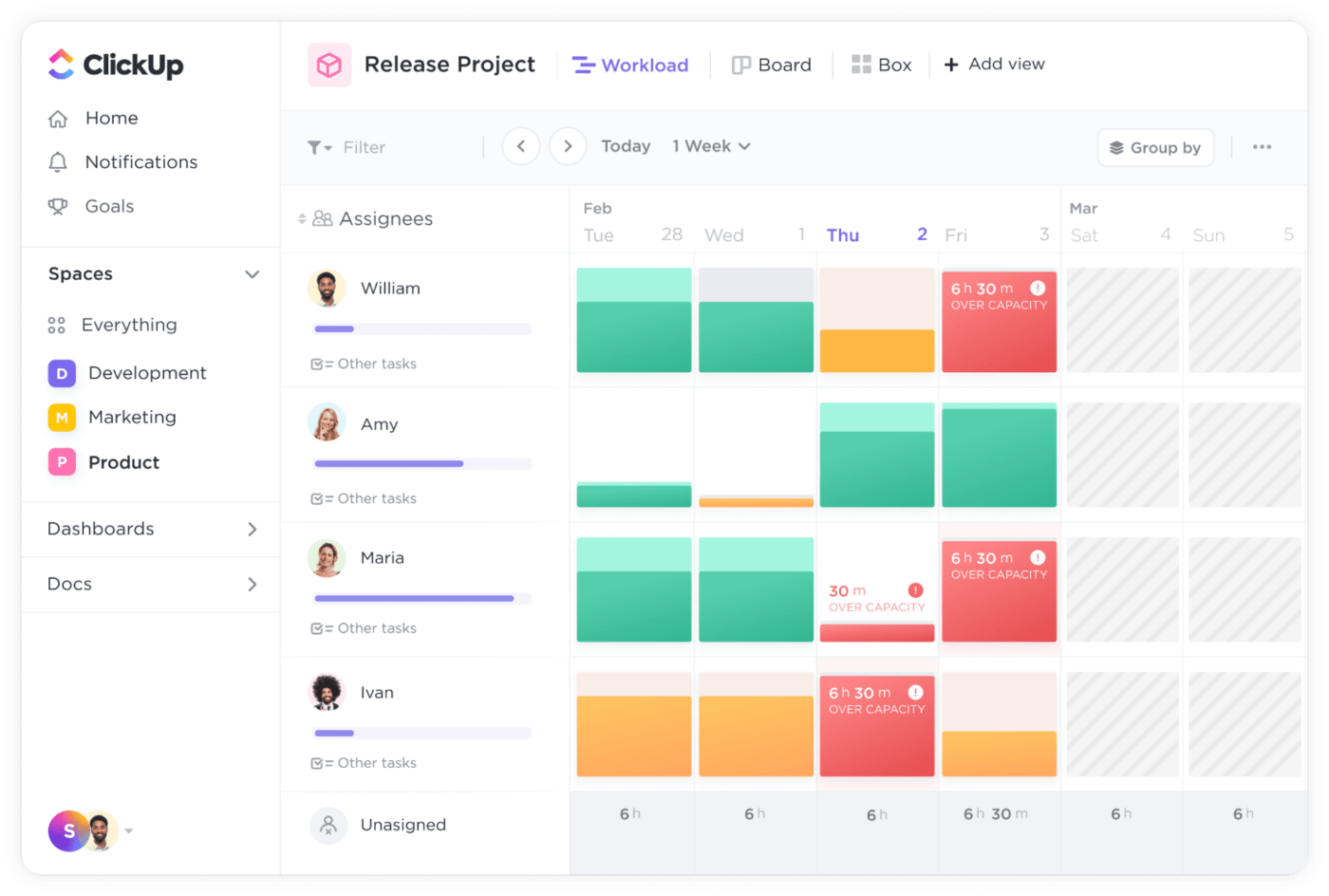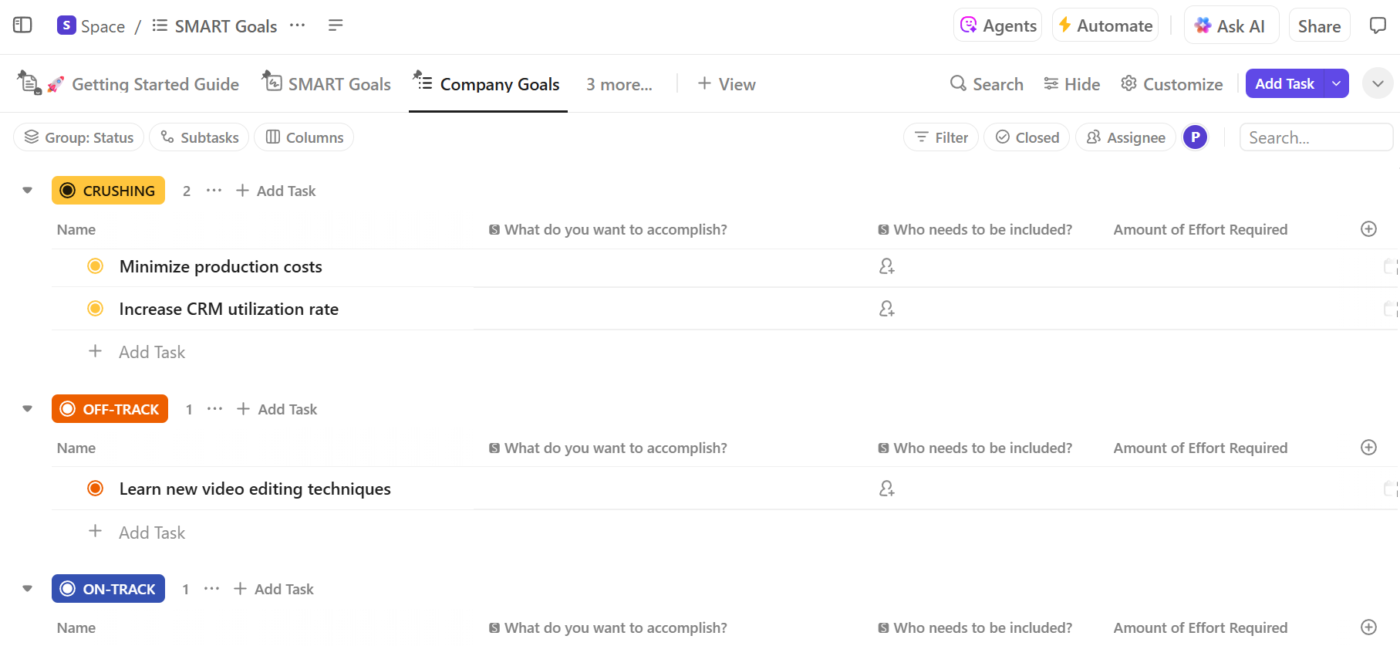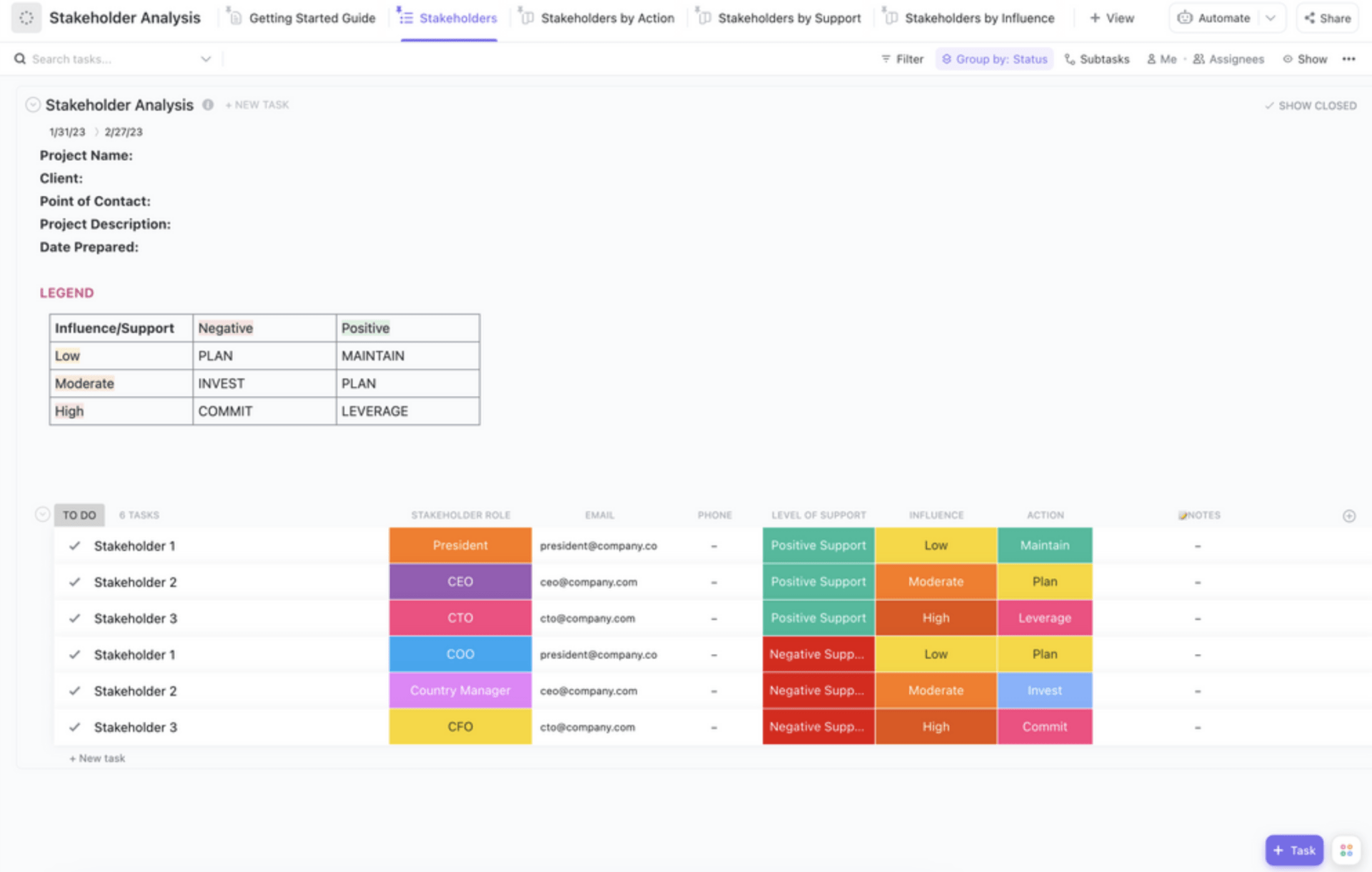It may seem like January gets all of the goal-setting glory amidst the thrill of a new year. However, many of us in the working world are lucky enough to relive this excitement three extra times at the start of each fiscal quarter. 🎉
Admittedly, this does look a little anxiety-inducing on paper, but does anyone else secretly love planning out their new objectives?
If you answered yes to this question, then we are the same type of weird. 🥲💜
The act of setting new goals can be such a validating experience. There’s just something about setting and reaching goals that feels inherently natural and just good.
Plus, a mix of personal and professional objectives is also necessary to thrive in careers, like project management, that are constantly innovating.
Here, we’ve compiled the tools and tips you need to set and stick to your upcoming project management goals. Plus, detailed project manager-specific objectives to kick off your quarter with a strong start and a couple of handy templates!
- Why should you set project management objectives & goals?
- The makings of a great project management goal
- 8 strong goals for project managers
- 1. Improve communication and collaboration
- 2. Improve productivity and performance
- 3. Achieve the project objectives within the given constraints
- 4. Stay proactive to mitigate risks in advance
- 5. Gain a strategic understanding of company goals and implement similar initiatives
- 6. Manage stakeholders expectations
- 7. Upgrade your skills and certifications, expand your PM knowledge
- 8. Maximize your contributions
- Project management goals that may not be SMART, but are smart
⏰ 60-Second Summary
- Project management goals provide direction, keep teams aligned, and drive project success
- Setting SMART goals ensures they are Specific, Measurable, Achievable, Relevant, and Time-bound for better clarity and execution
- Types of project management goals include scope, time, cost, quality, risk, and stakeholder management to cover all key areas
- Strong goal-setting helps teams stay focused, improve collaboration, and track progress effectively
- Aligning goals with company objectives ensures that projects contribute to overall business success
- Common challenges include unclear objectives, unrealistic expectations, and lack of tracking—but can be overcome with the right strategies
- ClickUp helps teams set, track, and achieve project goals with features like Goals, Dashboards, and custom templates
- Using ClickUp’s goal-setting tools ensures teams stay organized and productive throughout the project lifecycle
Why Should You Set Project Management Objectives & Goals?
I mean, you’ve got your project roadmap. That’s gotta be enough, right? Not quite.
Your roadmap may lay out the journey through a successful project launch, but the benchmarks along the way are where the real magic happens, especially when it comes to your professional development goals.
Before we dive in, we have a little disclaimer. In this post, we’re going to use the words “goals” and “objectives” interchangeably. You might have previously held separate definitions for these words, but in the context of this article, they are synonymous.
Phew, glad we got that out of the way. Now onto the good stuff. 🤓
Project management is exciting because it’s varied and allows project managers to learn something new almost every day. Setting goals helps you keep up with changing trends and ultimately deliver a product that will bring your stakeholders to (happy) tears.
Since setting goals in project management is such a great way to improve the quality of your projects, it is, by extension, also an excellent way to improve yourself! By aligning your own project management goals with the overall direction of your company, you are committing to the success of your future self.
Aside from bettering yourself, planning out the key objectives you want to achieve in each upcoming project is a great way to stay motivated, stand out, measure your growth, and prepare for the future. But that’s not all!
There’s another (pretty serious!) reason why you should invest some extra time into project management goals. 😳
Project managers are also facing new challenges with the rise of remote work and freelancing. Clear and SMART objectives are even more important to stay on top of potential changes that may lie ahead.
The teams best able to combat change are the ones most willing to pivot and define their project’s key objectives from the get-go.
Luckily, ClickUp’s got you covered. 🙂
The Makings of a Great Project Management Goal
At ClickUp, we are big fans of SMART goals, and the most impactful project management objectives share this quality!
A quick recap: SMART goals should be the North Star of your goal-setting journey. They are defined as being specific, measurable, achievable, relevant, and time-based.
- To be specific, your goal will answer the what, who, when, where, why, and which involved in a detailed action plan
- You will have a defined set of metrics to measure progress and know the skills or tools needed to attain it
- Your objective will also be relevant to you! Meaning it aligns with your career development or long-term personal goals
- Last but not least, it is time-bound with a deadline to kick any procrastination habits to the curb
SMART project management goals can be short term or long term, and many long term goals can be divided into more manageable milestones along the way.
We’ll share examples of both and everything in between! Including a few extra healthy work habits that can have a big impact on your way to reaching new heights.
8 Recommended Goals for Project Managers
This list combines short-term and long-term goals, but these are goals you can set for yourself repeatedly. With each new project, use the same SMART logic to measure your progress over an extended period of time, using these goals as your baseline.
Also, you can work on all of these objectives in tandem! The intention behind the order of the list is for each goal to build upon the previous one, but if you are a seasoned project manager, be our guest and skip around as you please. 🚀
1. Improve communication and collaboration
This may be a short-term goal, but it’s here for the long haul. Even if we didn’t suggest improved communication and collaboration as a top priority, this objective would likely still have a place in your group because good communication requires constant effort!
Now, if you are currently asking yourself, but if I’m always going to have to work on communication, then isn’t the goal not time-bound and therefore not SMART?
No. It’s still SMART.
Be clear and thoughtful about how you define “improvement” in this area, looking back on past projects or recent challenges. Can you now retrace lines of miscommunication back to their root causes?
Maybe this comes from too many communication channels. For example, Susan loves email, but Jimmy prefers Slack, and you’d rather put a pin in it until everyone can just hash it out over Zoom on Monday.
I sincerely hope that is not your current situation. 👀
Pro Tip: Identify the pain points and start laying out a solution in writing for the project team to follow and refer back to.
ClickUp’s Communication Matrix Report Template helps you and your team:
- Eliminate redundant efforts and streamline processes for maximum efficiency
- Visually map out who talks to whom and how frequently
- Identify potential communication gaps to ensure everyone is in the loop
Now your team knows when, where, and how to talk to each other.
While managing the team, guide the conversation by encouraging open communication and team collaboration. Especially for remote project teams, ensure that no one feels as though they’re working in a silo. Establish an “open door” policy when it comes to addressing questions, needs, and feedback.
Project manager pro tip: if you’re going to encourage the team to connect and share new ideas, make sure you’re willing to listen too.
📮ClickUp Insight: 83% of knowledge workers rely primarily on email and chat for team communication.
According to research by ClickUp, fragmented communication, involving scattered messages across multiple channels, hinders productivity.
To prevent unnecessary platform hopping and siloed communication, try ClickUp, the everything app for work.
2. Improve productivity and performance
This project management objective doubles as a short-term and long-term goal!
The way you implement this goal will depend on your company’s current practices, but it ultimately comes down to how you measure productivity and performance.
Look back at past projects, tasks, milestones, and timelines—are you consistently sticking to your deadlines? And if not, can you find the cause of potential low-performance areas?
Bottlenecks and blockers are sometimes completely out of your control, but conducting a full audit of your team’s workload and the pace of your projects is never a bad idea. It may give way to new areas for improvement that you hadn’t seen before.
Pro Tip: Invest in a productivity tool that can handle time tracking, real-time reporting, deadlines, and team workflows!
Use these Performance Review Templates!
For example… 👀
Flexible time-tracking features in ClickUp help you focus on your work with a global timer, time estimates, and reports breaking down your time per task. Plus, with ClickUp’s Chrome Extension, you can even track the time you spend outside of ClickUp, and get the full picture of your workload from truly anywhere on the web.
You can then take time management a step further with ClickUp’s unique Workload view to see how the time estimates of your tasks measure up against the time you have in your week.
This is an excellent way to help structure your days and make sure everyone knows what to work on.

3. Achieve the project objectives within the given constraints
While it can be exciting to set new goals, make sure you never lose sight of the big picture! Your project objective, scope, time, quality, and budget must be upheld.
Delivering your projects within the set time and budget are the two most important requirements as a project manager. Missing deadlines, falling behind, and going over budget not only affects your reputation as a project manager, but also potentially impacts your product’s profitability and ultimately your company.
Pro Tip: Software like ClickUp gives you the tools you need to stay on track with your goals. ClickUp Dashboards provide real-time updates to ensure you never lose sight of what’s up.
Think of ClickUp’s Dashboards as your high-level home base for developing Sprints, resource leveling, and progress monitoring. But what’s really cool about Dashboards is that you can create one for virtually any scenario. Instantly pull progress based on goals, milestones, tasks, time, activity, and more.
With over 50 cards to customize how you display your wins, ClickUp Dashboards are an excellent tool for presenting to stakeholders.
Bonus: Project Management KPIs!
4. Stay proactive to mitigate risks in advance
AKA, always have a contingency plan.
Falling behind on a project can sometimes be out of your control and eventually happens to everyone. Maintain a competitive edge and establish yourself as a proactive leader by having a process in place to move forward when things don’t go your way.
Pro Tip: Gantt Charts in ClickUp can surface blockers and dependencies so you can tackle them ahead of time!
The Simple Gantt Template by ClickUp gets you set up quickly to track your project and deadlines.
Having contingency plans in place can help you stay on track, even with a few bumps.
Brainstorm with the team about the risks, roadblocks, and outcomes you may encounter on your project roadmap. Adjust as needed in the planning stage to stay ahead and avoid potential pitfalls.
For long-term goal project planning, keep a risk assessment document, template, or task in place to look back on how risks were handled in recent projects to learn from them in the future.
Pro Tip: Get familiar with risk management tools and risk register templates.
5. Gain a strategic understanding of company goals and implement similar initiatives
Implementing this long term goal can help you execute high-impact projects and play a bigger role in the company wins down the line. Take this as a sign to break away from your usual bubble and create initiatives that contribute to the company’s larger purpose!
Knowing what your company’s larger goals are and why they’re important can help guide your own project management goals and help you make more strategic decisions about your projects.
It was found that 30% of a business’ projected benefits are achieved from implementing a new project, and about 70% of those benefits will come from putting in place a process for holding people accountable and having a system to make the long term benefits of a project known.
Basically, this will help you see how your project’s success impacts the company as a whole.
6. Manage stakeholders’ expectations
Stakeholders are the support system of your organization; you could even think of them as your project sponsors.
As a project manager, you will be asked to keep them informed about the project at every milestone and incorporate their feedback because believe it or not, they have their own personal objectives too! To succeed with this goal you’ll want to increase transparency into your project’s progress, visibility into the team’s efforts, and get everyone on the same page ASAP.
We suggest starting with a review template! Include a summary of the big picture, updates since the last review, any questions, additional needs, etc. Having a project management tool (like Clickup!) with the ability to create dashboards and instantly pull up-to-date insights on your project at a moment’s notice will also help you tremendously.
Beyond transparency, you’ll also want to create a standardized process for receiving your stakeholders’ approval, feedback, and communication. 🙂
Pro Tip: The ClickUp Stakeholder Analysis Template simplifies stakeholder management and ensures project success. It helps teams evaluate stakeholder power, influence, and interest, paving the way for effective communication and collaboration.
7. Upgrade your skills and certifications, expand your PM knowledge
A great way to stay on the cutting edge of your industry is to remember that we are never done learning!
About 51% of organizations now require project managers to hold a certification.
Set a goal to continuously improve your skills through certifications, training, and staying updated with industry trends and project management tools. This can enhance your effectiveness as a project manager. Learning from past projects and applying those insights to future initiatives is key to long-term success.
There are a ton of courses that allow you to learn at your own pace and within your personal time constraints. Plus, this is a great way to show that you take the initiative to innovate and hold yourself accountable by wanting to improve.
Check out these Goal-Setting Templates!
8. Maximize your contributions
This is a long-term goal, largely because it takes time, trial and error, and skill to learn how to do the most in the role you currently have without totally burning yourself out.
Expand your impact step by step and think beyond your current responsibilities. Maybe you start taking a greater interest in training new team members and retaining them! Or perhaps you work with management to create new team goals, research your competitors, or look at old performance reports to create new improvement strategies.
Pro Tip: ClickUp’s Career Path Template is designed to help you visualize and track your career progression.
Project management goals that may not be SMART but are smart
Though these three project management goals may not be SMART as defined earlier in this post, they are great habits to keep in mind and will take you far in the way of leadership!
1. Work on your soft skills
It is important to be a well-rounded asset. Have a healthy mix of technical knowledge, business knowledge, and a working knowledge of how to communicate with your team, clients, stakeholders, etc. This also relates to negotiating skills and knowing how to get things done without burning any bridges.
This can help you avoid conflicts and promote a collaborative and functional work culture!
2. Balance strategic goals with employee needs
Remember: be a human first.
We mentioned that one of the main objectives of a good project manager is to stay on the project budget, which includes ensuring that your company does not have to hire replacements constantly. 👀
Without the team, you will not have a project or a product. Employee satisfaction is important to keep the team engaged in the project because it is not only in the best interest of the employee to have their needs in mind, but also the best interest of the product.
Communicate transparency with your team and hold regular one-on-one sessions to normalize giving feedback and create a relationship between yourself and your team members. Take interest in their own goals and hold reviews to help them celebrate the benchmarks they’ve reached while identifying areas to grow.
Check out these budget proposal templates!
3. Lead by example
If you are going to hold your team accountable for their actions, you need to hold yourself accountable too!
In tough times, try asking yourself what kind of leader you would want to have if the roles were reversed. Try not to let personal feelings or outside influences change your perception of a chain of events, and remember to look at every situation from all sides to gauge the type of leader needed at that moment.
Know when to delegate, when to step in, and when it’s just best to listen.
You’re ready!
The magic of these project management goals is that you can continue applying them with every new project or at the start of each fiscal quarter.
Remember: investing in improving the quality of your projects means you’re also investing in yourself.
The sky is the limit, but when in doubt, think SMART. And when you’re ready to take your project management goals a step further, get yourself a free ClickUp account. 🥳









